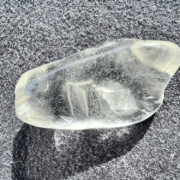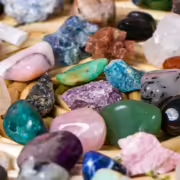Prasiolite stone – properties, virtues & benefits
Lithotherapy uses Prasiolite, a rare gemstone, for its physical and psychological benefits. This pale to medium-green stone is also known as the “leek-colored stone”. Although rare in its natural state, it can be created by heating amethysts to change their color and size.
PRASIOLITE CHARACTERISTICS
- Chakra: Heart.
- Properties: Calming, balances emotions, promotes creativity, stimulates intuition.
- Astrology: Pluto.
- Zodiac: ScorPio.
- Elements: Earth, air.
- Colors: Olive green, yellow-green.
- Hardness: 7 on the Mohs scale.
- Chemical Formula: SiO2 (silicon dioxide).
- Associated god: Bacchus/Dionysos (Roman/Greek god of wine and vine).
PRASIOLITE – HIS HISTORY
Prasiolite is a rare mineral formed in magmatic formations. Its name comes from the combination of the Greek terms “prason” (leek) and “lithos” (stone) due to its unique green color. Although it is sometimes confused with Prase, it’s crucial to understand that these two minerals are different.
PRASIOLITE STONE – ITS ORIGIN AND COMPOSITION
Prasiolite is a single-crystal variety of quartz with a pale to medium green color, which comes in various sizes and weights. Although rare in its natural state, it can be produced by heating amethysts located near volcanoes. Commercially available stones are often artificially heated amethysts or irradiated quartz, also known as “greened amethysts”. Prasiolite has a hardness of 7 on the Mohs scale and a density that influences its weight and size. It is found mainly in California, Poland and Canada.
Prasiolite is obtained by heating purplish or gray amethyst to 650°C, as is the case with stones from the Montezuma mine in Brazil. In nature, some green gems form naturally when amethyst deposits are located near volcanoes, as in California, where the amethysts turned green due to a rhyolitic lava flow. Artificially heated amethysts often turn yellow and approach citrine, while those heated too strongly become colorless.
Prasiolite is often confused with synthetic green quartz, but impurity analysis can differentiate between the two. Nor should it be confused with Prase quartz, which is a quartz with green inclusions. This relatively recent stone has no associated legends or myths, but today it is cut into facets for use in jewelry.

PRASIOLITE STONE – VERTIES AND PROPERTIES
Prasiolite is a gemstone that belongs to the self-confidence stones and is known for its beneficial effects on mental and physical health.
Prasiolite enables you to assert yourself while remaining respectful, helPing you to become aware of your own worth and develop self-esteem. It helps combat complexes caused by failures or excessive self-criticism, making it a useful stone for boosting self-confidence.
PRASIOLITE ON THE PSYCHOLOGICAL LEVEL
Prasiolite is a gemstone in the self-confidence category, known for its beneficial effects on the psychological and physical levels.
Prasiolite helps to assert oneself while being respectful, promoting self-awareness and self-esteem while combating complexes caused by failures or excessive self-criticism. It encourages self-love and openness towards others, fostering compassion, empathy and understanding. The stone also brings optimism, joy and vitality, combating feelings of sadness, anguish and anxiety.
Prasiolite strengthens charisma, the mind and willpower, helPing to overcome life’s obstacles and achieve set goals. It is also reputed to strengthen the bonds in a couple, sustain physical desire and maintain dialogue.
PHYSICAL PRASIOLITY
Prasiolite is known to fight addictions and protect against external pollutants, making it a protective stone. It provides energy and vitality, fights intense sadness and encourages the taking on of new projects, such as resuming sport or adopting a balanced lifestyle. It also promotes the proper functioning of the solar plexus chakra and combats stress and its harmful consequences on the body, helPing to relieve tension and facilitate the proper circulation of bodily fluids.
There are many ways to use the Prasiolite stone in lithotherapy, such as wearing it as jewelry, placing it on the solar plexus chakra during a meditation or relaxation session, keePing it near your workplace to improve self-confidence and communication with colleagues, or arranging it in your bedroom to strengthen emotional bonds and encourage dialogue with your partner.
To purify and recharge the Prasiolite stone, simply place it in natural sunlight or moonlight for a few hours, or bring it into contact with other energetic stones, such as amethyst or rock crystal. Although Prasiolite has a hardness of 7 on the Mohs scale, it should be handled with care to avoid damage or breakage.

PRASIOLITE STONE – CLEAN AND RECHARGE
Prasiolite stone, also known as green amethyst, can accumulate negative energies over time and therefore needs regular cleansing and recharging to maintain its properties. Here are some methods for cleansing and recharging your prasiolite stone:
Cleaning:
- Clear water: Rinse the stone in clear water for a few minutes to eliminate any negative energy.
- Fumigation: pass the stone through sage or palo santo smoke to cleanse negative energies.
- Earth: Bury the stone in the ground for a few hours to recharge with earth energy.
Loading:
- Sunlight: Place the prasiolite stone under sunlight for a few hours to recharge.
- Moonlight: Expose the prasiolite stone under the light of a full moon for one night to recharge.
- Crystals: place the prasiolite stone on a cluster of crystals such as amethyst or quartz to recharge it with their energy.
It is recommended to clean and recharge your prasiolite stone regularly, depending on use and the vibrations it absorbs.
WHERE DOES THE NAME PRASIOLITE COME FROM?
The name “prasiolite” is derived from two Greek words: “prason”, meaning “leek”, and “lithos”, meaning “stone”. This refers to the olive-green color of the stone, which resembles the color of leek leaves. The name prasiolite is often used to refer to varieties of quartz that have been heated to obtain their green color, although some natural unheated green stones can also be called prasiolite. This stone is also known as green amethyst due to its similarity to amethyst in shape and hardness, but with a different color.
WHICH CHAKRA DOES PRASIOLITE ACT ON?
Prasiolite, also known as green amethyst, acts primarily on the heart chakra. This chakra is located in the center of the chest and is associated with love, compassion, harmony and emotional balance. Prasiolite is considered a healing stone for the heart chakra, as it can help release emotional blockages and promote the opening and expansion of this chakra. It can also help stimulate empathy and understanding of others, as well as foster inner peace and self-confidence.
WHICH ASTROLOGICAL SIGN IS ASSOCIATED WITH PRASIOLITUS?
Prasiolite, also known as green amethyst, is associated with the astrological sign of ScorPio. Stones associated with ScorPio have traditionally been considered beneficial for this zodiac sign due to their ability to enhance positive qualities and mitigate potential flaws associated with this sign. Prasiolite can help ScorPios connect with their own intuition and release repressed emotions, promoting emotional healing and personal growth.
PRASIOLITE STONE SUMMARY
Prasiolite stone, also known as lemon green quartz or green amethyst, is a pale to medium green semiprecious stone. It is often confused with peridot, but is actually a variety of quartz that owes its green color to exposure to heat and radiation. Prasiolite is often used in jewelry to create necklaces, rings and earrings. It is also considered to have healing properties and is used in lithotherapy to relieve stress, anxiety and physical pain.



